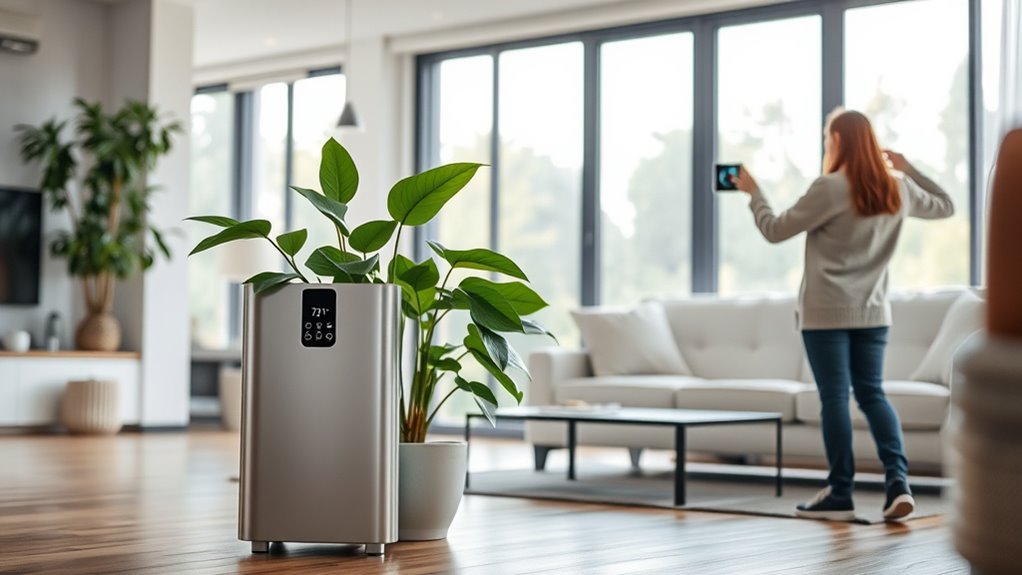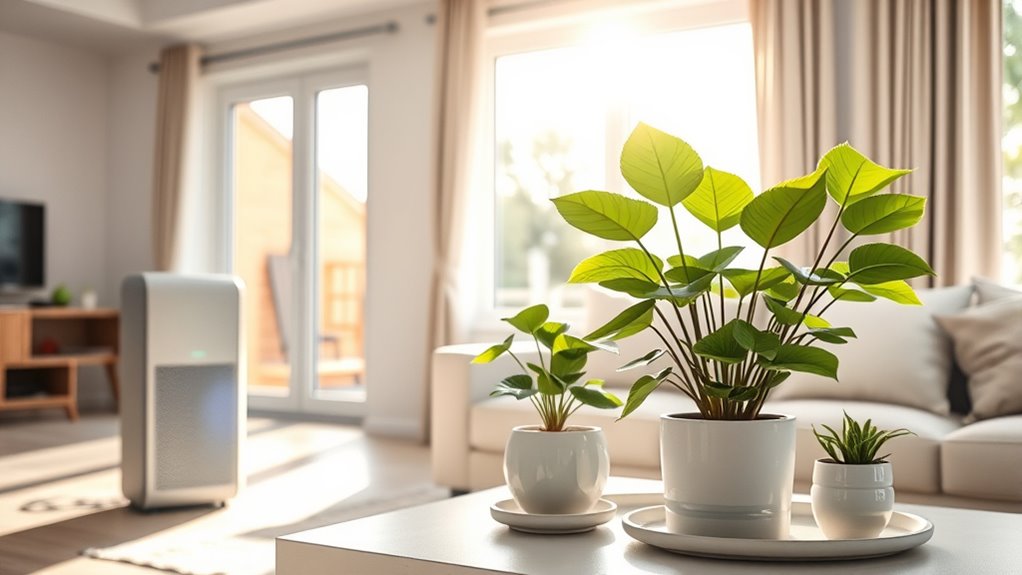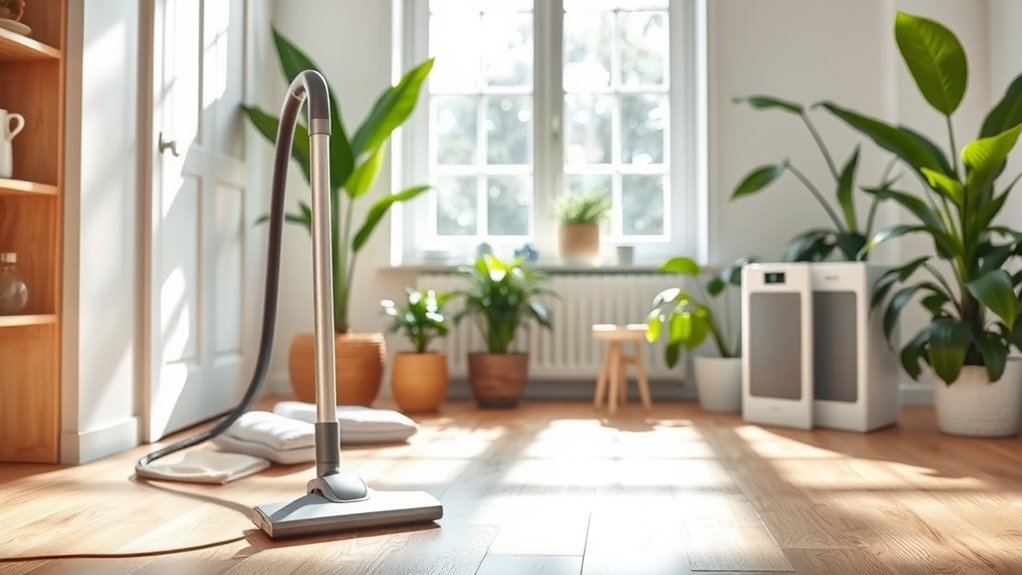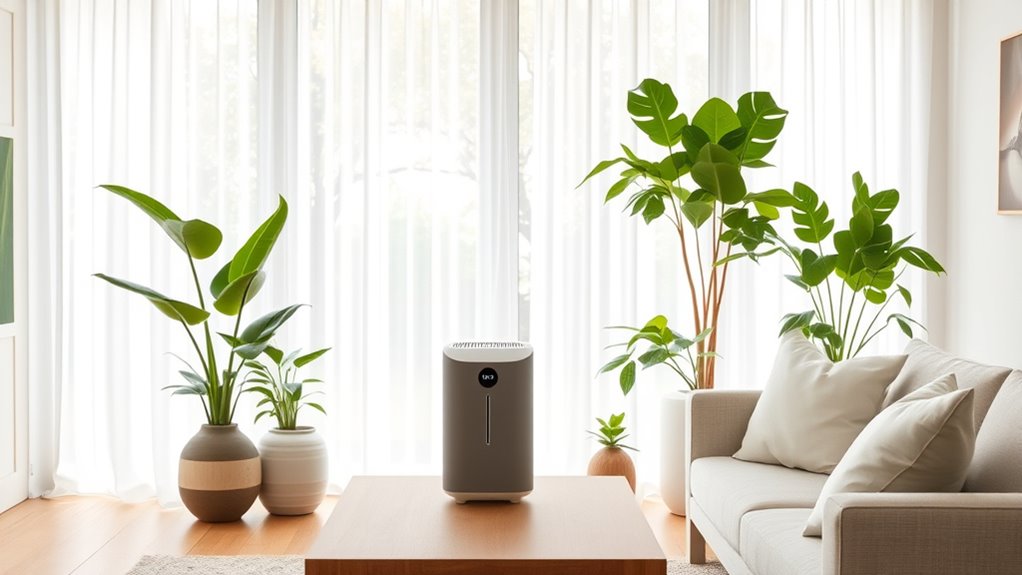To guarantee good indoor air quality, check your ventilation systems work well, and increase natural airflow by opening windows. Keep humidity levels between 30-50% using humidifiers or dehumidifiers, and monitor with a hygrometer. Reduce pollutants by choosing natural cleaning methods, groom pets regularly, and avoid smoking indoors. Use air purifiers properly, and eliminate sources like harsh chemicals. Staying consistent with these steps helps maintain fresh air—if you want detailed tips, you’ll find more helpful advice below.
Key Takeaways
- Regularly assess and maintain ventilation systems, ensuring proper airflow and fresh air exchange indoors.
- Monitor humidity levels between 30-50% using hygrometers; adjust with dehumidifiers or humidifiers as needed.
- Minimize indoor pollutants by reducing chemical use, managing pet dander, and avoiding smoking indoors.
- Choose appropriate air purifiers, maintain filters, and position devices correctly for effective air cleaning.
- Eliminate common pollution sources like harsh cleaners and chemical products, and promote proper ventilation.
Assessing and Improving Ventilation

Proper ventilation is essential for maintaining good indoor air quality, as it helps remove indoor pollutants and bring in fresh air. To assess your current ventilation, check if your ventilation systems are functioning correctly and providing adequate air exchange. Look for signs like persistent odors, excess humidity, or stale air, which indicate poor airflow. Improving ventilation may involve upgrading or maintaining existing systems, such as exhaust fans, HVAC filters, or installing air purifiers. Ensure vents are unobstructed and operate regularly. Consider increasing natural ventilation by opening windows or adding vents if possible. Regularly inspecting and maintaining your ventilation systems guarantees proper air exchange, reducing pollutants and enhancing overall indoor air quality. Proper ventilation is a crucial step toward a healthier indoor environment.
Monitoring and Managing Humidity Levels

Monitoring and managing humidity levels is key to maintaining healthy indoor air quality. Proper humidity control prevents problems like mold growth, dust mites, and respiratory issues. You should aim to keep indoor humidity between 30% and 50%. Use a reliable hygrometer to regularly check moisture levels. If humidity is too high, consider using dehumidifiers or increasing ventilation to reduce excess moisture. Conversely, if it’s too low, adding humidifiers can help maintain comfort and prevent dryness-related issues. Moisture management is essential for creating a balanced environment that discourages mold and bacteria growth. Consistent monitoring allows you to adjust your humidity control methods as needed, ensuring your indoor air remains safe, comfortable, and free of excess moisture that can compromise air quality.
Reducing Indoor Pollutants and Contaminants

Have you ever wondered what’s lurking in your indoor air? To reduce pollutants and contaminants, start by choosing air freshener alternatives like natural oils or simmering herbs instead of chemical sprays. These options eliminate strong odors without adding harmful chemicals. Pet dander management is also essential if you have animals; grooming your pets regularly and washing their bedding helps limit airborne allergens. Keep surfaces clean and vacuum frequently with a HEPA filter to trap dust, pet hair, and other particles. Avoid smoking indoors and minimize the use of harsh cleaning products, opting for eco-friendly options. Ventilate your space when possible to let fresh air in and stale air out. These simple steps greatly improve indoor air quality and create a healthier environment for everyone.
Choosing and Maintaining Air Purification Devices

Choosing the right air purification device is essential for effectively improving indoor air quality. To maximize benefits, consider device placement—avoid corners and obstructions for ideal airflow. Regular air purifier maintenance, like changing filters as recommended, keeps the device running efficiently. Proper placement and upkeep ensure you get the most out of your investment and maintain clean air.
| Device Type | Best Placement Tips | Maintenance Tips |
|---|---|---|
| HEPA Filter | Central location, away from walls | Change filters every 6-12 months |
| Activated Carbon | Near pollution sources | Clean exterior regularly |
| Ionizer | Elevated, not obstructed | Check for buildup, clean as needed |
| UV Purifier | Near air intake vents | Replace UV bulbs annually |
| Portable | In living areas, away from electronics | Keep filters clean and replace periodically |
Eliminating Common Sources of Indoor Air Pollution

To improve your indoor air quality, start by reducing smoking inside your home, as it releases harmful pollutants. Also, try to minimize the use of chemical-based products like cleaning supplies and air fresheners. Taking these steps can make a noticeable difference in creating a healthier environment for you and your family.
Reduce Indoor Smoking
Indoor smoking considerably contributes to poor air quality, releasing harmful chemicals and particulates that can affect everyone in your home. Cigarette smoke and tobacco fumes contain toxins that linger in the air and settle on surfaces, increasing health risks for all residents. To improve indoor air quality, consider these steps:
- Make your home smoke-free to prevent contamination from cigarette smoke.
- Encourage smokers to do so outside to keep harmful fumes out of living spaces.
- Use air purifiers with HEPA filters to reduce residual tobacco fumes that may remain indoors.
Minimize Chemical Use
Chemical sources are a major contributor to indoor air pollution, releasing toxins that can harm your health over time. To reduce these risks, opt for natural remedies instead of chemical-laden products whenever possible. Choose chemical alternatives like vinegar, baking soda, or essential oils for cleaning and air freshening, which are safer for your indoor environment. Be mindful of household items such as paints, adhesives, and air fresheners, which often emit volatile organic compounds (VOCs). By minimizing chemical use and switching to natural remedies, you create a healthier space. Regularly ventilate your home to help dissipate any lingering pollutants. Small changes make a big difference in improving indoor air quality and protecting your long-term health.
Regular Cleaning and Dust Control Practices

Regular cleaning and dust control are essential steps in maintaining good indoor air quality. They help reduce airborne allergens and improve overall freshness. Regularly dust surfaces with a damp cloth to trap dust mites and prevent their spread. Vacuum carpets and upholstery frequently, using a HEPA filter to effectively remove dust mite allergens. Keep clutter to a minimum, as it collects dust and hampers cleaning efforts. Consider using removable covers on bedding and furniture for easier dust mite control.
- Use HEPA filters in vacuum cleaners and air purifiers to trap airborne allergens
- Wash bedding and curtains weekly in hot water to eliminate dust mites
- Keep humidity levels below 50% to prevent dust mite proliferation
Promoting Healthy Habits for Better Air Quality

Adopting healthy habits can considerably enhance the air quality in your home. Increasing your air quality awareness helps you make smarter choices, like avoiding smoking indoors or using strong chemicals. Maintaining a healthy lifestyle involves regular exercise, proper nutrition, and avoiding habits that introduce pollutants, such as burning candles excessively or neglecting ventilation. Simple actions like opening windows daily, using exhaust fans, and reducing clutter decrease dust and allergens. Stay mindful of how products like cleaning supplies and air fresheners affect your indoor environment. Educating yourself on indoor air quality empowers you to create a cleaner, healthier space. By integrating these habits into your routine, you actively contribute to better air quality, making your home safer and more comfortable for everyone.
Frequently Asked Questions
How Often Should I Replace My Air Filters for Optimal Air Quality?
You should replace your air filters every 1 to 3 months for peak air quality. Regular filter maintenance helps prevent dust, allergens, and pollutants from circulating. Keep an eye on your filter’s condition and change it more frequently if you have pets or allergies. Also, schedule regular HVAC checkups to guarantee your system runs efficiently. Proper filter maintenance and HVAC scheduling are key to maintaining healthy indoor air.
Can Houseplants Significantly Improve Indoor Air Quality?
Yes, houseplants can considerably improve indoor air quality through natural air purification. By choosing the right plant selection, you can target specific pollutants like formaldehyde or benzene. Incorporate plants such as snake plants or peace lilies to boost air quality naturally. Keep in mind, for maximum benefit, regularly care for your plants and combine them with proper ventilation to create a healthier indoor environment.
What Are the Signs of Poor Indoor Air Quality?
If you notice persistent headaches, sneezing, or coughing, your indoor air quality might be poor. Signs include airborne allergens like dust or pet dander, and mold indicators such as a musty smell or visible mold spots. You might also feel fatigue or difficulty breathing. These symptoms suggest airborne allergens and mold are affecting your environment, so it’s essential to improve ventilation, clean regularly, and address any mold issues promptly.
How Does Outdoor Pollution Affect Indoor Air Quality?
Ironically, outdoor pollution impact sneaks inside your home, making it harder to breathe. When outdoor air is polluted, it infiltrates your living space through open windows, vents, or tiny gaps, bringing outdoor pollutants like smog, pollen, and chemicals indoors. This infiltration worsens indoor air quality, exposing you to harmful substances you might not realize are invading your sanctuary. So, outdoor pollution isn’t just a distant problem — it’s an indoor concern too.
Are Air Purifiers Effective Against All Types of Indoor Pollutants?
Air purifiers are effective against many indoor pollutants, but their efficiency depends on the types of air purifier and pollutant removal efficiency. HEPA filters excel at trapping dust, pollen, and pet dander, while activated carbon filters remove odors and chemicals. However, they may not eliminate gases like radon or certain VOCs. To maximize indoor air quality, choose an air purifier suited to your specific pollutants and guarantee proper maintenance.
Conclusion
By following this checklist, you’ll breathe easier and create a healthier indoor environment. Regularly assess your ventilation, keep humidity in check, and stay vigilant about pollutants—think of it as your modern-day equivalent of a Victorian housekeeper’s diligence. Remember, maintaining good air quality isn’t a one-time task but a continuous effort. Stay proactive, and your home will be as fresh and inviting as a summer breeze, even if it’s a bit more “hip” than a cobwebbed parlor.










